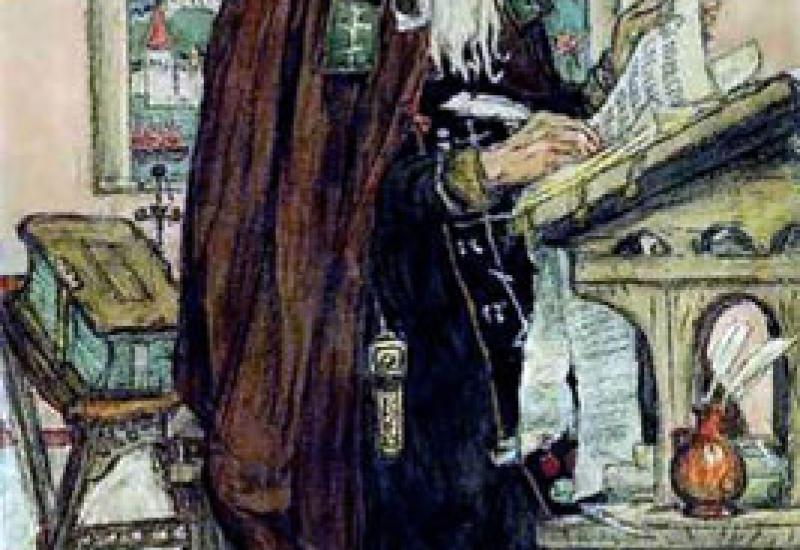This holiday was established by decree of the President of Ukraine in 1997 and is celebrated annually in honor of Ukrainian chronicler Nestor, who was a follower of the creators Slavic alphabet Cyril and Methodius. This year it is celebrated on the state level the anniversary 995 years of St. Nestor the Chronicler, first Ukrainian historian, outstanding writer and thinker, monk of Kyiv-Pechersk Lavra. The decree was adopted by Verhovna Rada of Ukraine.
Researchers believe that Ukrainian written language begun with Nestor Chronicler. This is not only state but also religious holiday. The first modern Ukrainian language work, which corresponds to the Byzantine roots was named by the Orthodox akathist Virgin Holmsk.
St. Nestor Chronicler was from Kiev, seventeenth years old he came to Kiev-Pechersk Lavra as a novice. He was taken by the monastery founder Feodosiy. By prayer and obedience the young novice overtook some outstanding elders. During the vows as a monk Nestor was awarded the rank of deacon. The books were the sense of his life.
The most important work of Nestor Chronicler was “The tale of Bygone Years” –chronicle reports, composed in Kiev at the beginning of XII century. This is the first note in Kiev Rus , where the state history is shown on the background of the world events. St. Nestor’s story was continuing from end of XI century up to 1113 year. All following chronicles only rewrote some excerpts from the St. Nestor work. But they could not overcome it. “The tale of Bygone Years” was and will the most outstanding monument of Slavic culture. Thus St. Nestor Chronicler could be regarded as a father not only country’s history but also literature.
Characterizing the work of Nestor Chronicler on should note the two other his works, which appeared before the “Tale of Bygone Years”. They are: “Reading about the life and death of Boris and Gleb”, written in 1081-1088, and “The life of St.Theodosius, abbot of Pechera Monastery. Written by Nestor, monk of the same monastery”(about 1091). The main idea of Nestor’s life of Saint Martyrs Boris and Gleb is that they were martyred for the sake of brotherly love , have preferred death, and this means that contemporary princes who drowned in the strife, had to abide by the rules of Christian brotherly love, which is the main reason preserve the unity of. As for the other live - St. Theodosius, the researchers note that as a hagiographical work it evokes today a deep sense of wonder of the "art of the author, with whom he sews this colorful carpet and fragmentary episodes in the life of Theodosius bound and lively work in which the internal chronology and great accuracy equally respected. "
For several centuries the Ukrainian people was accustomed to the idea of secondry of Ukrainian language. The big amount of literature and culture was hidden from the Ukrainians. The culture which has a many thousand years history. The scientific research of linguists shows that the language of Ukrainian people started to be formed in VI-IX centuries.
One of the first who defined the basic stages in the development of the literary language of Ukraine was Yuriy Shevelov. He singled out the periods of the history of language not in view of the history of social formations. His chronology is based only on the facts of external nature written fixations, given the effects of social events and factors important in the history of Ukrainian people:
– VI, VIІ – ХІ ст. – Proto-Ukrainian language (prior to the written period);
– middle of ХІ – ХІV с. – old Ukrainian language;
– ХV – middle of ХVІ с. –early middle Ukrainian language (from 1385, when Lithuania and Poland united, up to 1574, when Apostol of Ivan Fedorov was printed in Lviv)
– middle ХVІ – half of ХVІІІ с. – middle Ukrainian language (from the Lublin Union of 1569 - an agreement on association of Poland and the Grand Duchy of Lithuania into one state - the Rzeczpospolita)
–XVIII century – late middle Ukrainian language (from Poltava battle 1709 up to publishin Enid of Kotliarevsky 1798);
– end of XVIII century – modern Ukrainian language.
Intensive formation of the new Ukrainian language the researchers connected with second half of XVIII-XIX centuries. Not the last place in this process is given to St. Nestor Chronicler.

